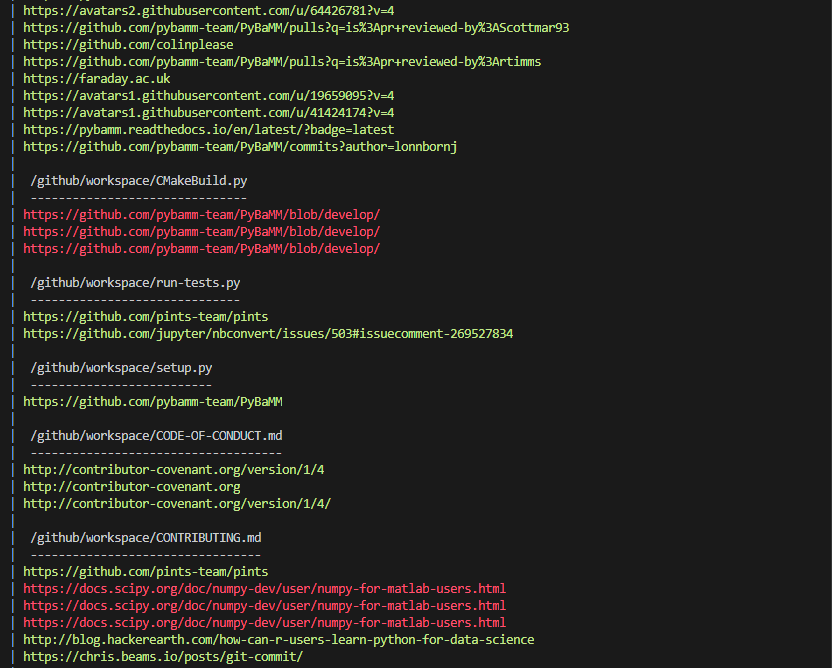Working on GitHub Actions

Priyanshu Agarwal
Posted on February 7, 2021

What are GitHub Actions?
According to GitHub:
GitHub Actions help you automate tasks within your software development life cycle. GitHub Actions are event-driven, meaning that you can run a series of commands after a specified event has occurred. For example, every time someone creates a pull request for a repository, you can automatically run a command that executes a software testing script.
I used GitHub actions to automate checking invalid links and to run custom scripts in a repository.
Steps
Create a file checker.yml inside .github/workflows
I recommend checking out the GitHub Documentation for basic syntax.
Using pre-defined templates
You can use pre-defined action templates and customize inputs according to your needs. You can look for them in the GitHub marketplace.
Link checker
This workflow will check all the files in your repository for broken and invalid links and report them.
- urlstechie/urlchecker-action
I used it because I had to use the link checker in various file types like .md, .rst, and even .py
For custom configurations, examples, and more details, refer to the repository.
name: Check URLs
on:
push:
schedule:
# Run everyday at 3 am UTC
- cron: 0 3 * * *
jobs:
urlchecks:
runs-on: ubuntu-latest
steps:
- uses: actions/checkout@v2
- name: URLs-checker
uses: urlstechie/urlchecker-action@master
with:
# A comma-separated list of file types to cover in the URL checks
file_types: .rst,.md,.py,.ipynb
# Choose whether to include a file with no URLs in the prints.
print_all: false
# Timeout in 10 seconds if url is not reached
timeout: 10
# How many times to retry a failed request (each is logged, defaults to 1)
retry_count: 5
- gaurav-nelson/markdown-link-check
If you are looking to work with just a single file type, then you should go with this one.
For custom configurations, examples, and more details, refer to the repository.
name: Check invalid links
on:
push:
pull_request:
schedule:
# Run everyday at 3 am UTC
- cron: 0 3 * * *
jobs:
markdown-link-check:
runs-on: ubuntu-latest
steps:
- uses: actions/checkout@master
- name: Run link check
uses: gaurav-nelson/github-action-markdown-link-check@v1
with:
use-quiet-mode: 'yes'
use-verbose-mode: 'yes'
Link to my pull request pybamm-team/PyBaMM#1347
Run custom python scripts and make a pull request
You can also run custom python scripts using workflows and can add a feature to automatically make a pull request to the repository.
name: Run custom scripts
on:
push:
# Add paths only if you want to run the workflow when a file is modified.
paths:
- 'folder/filename.py'
jobs:
build:
runs-on: ubuntu-latest
strategy:
# List all the python versions to test it with
matrix:
python-version: [3.7, 3.8]
steps:
- uses: actions/checkout@v2
- name: Set up Python ${{ matrix.python-version }}
uses: actions/setup-python@v2
with:
python-version: ${{ matrix.python-version }}
# Add all the required dependencies
- name: Install dependencies
run: |
python -m pip install --upgrade pip
pip install flake8 pytest
if [ -f requirements.txt ]; then pip install -r requirements.txt; fi
- name: Run script
run: python script.py
# Automatically create a pull request
- name: Create Pull Request
uses: peter-evans/create-pull-request@v3
with:
delete-branch: true
branch-suffix: short-commit-hash
commit-message: type your commit message
title: type your title here
body: |
Auto-generated pull request
Link to my pull request pybamm-team/PyBaMM#1371
How to test them?
There are mainly two ways to test workflows:
- Locally
To test them locally use nektos/act, which is free and open source.
Look at how to install it.

Note that GitHub actions currently do not support colors and you may see different results there.
- Pushing it on the fork
Another way to do it is by pushing all your files to your fork. It is recommended to create a new branch to test everything in it so that it does not interfere with your current branches.
Procedure
Run these commands in your terminal.
git checkout -b branchnamegit add workflow.ymlgit commit -m "workflow test-1"git push origin branchname
Then go to your fork and look for Actions
This is just a very small use case of what Github Actions can do. You might have some other way of doing the same thing too.
If you want to discuss more on this feel free to comment below.

Posted on February 7, 2021
Join Our Newsletter. No Spam, Only the good stuff.
Sign up to receive the latest update from our blog.

